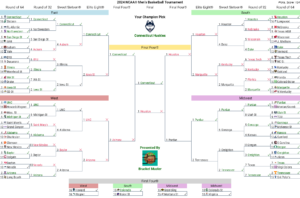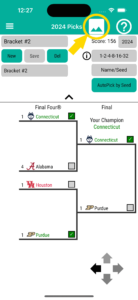Congratulations to the University of Kansas Jayhawks for their fourth NCAA men’s basketball championship, earned in their 50th tournament appearance. Kansas defeated the University of North Carolina Tarheels 72-69. The Jayhawks required the biggest comeback in championship game history. North Carolina led by 16 points with the score 38-22 shortly before halftime. Loyola University of Chicago held the previous record, erasing a 15-point second-half deficit to the University of Cincinnati in the 1963 championship game to overcome the Bearcats 60-58 in overtime.
North Carolina lost in the championship game for the sixth time in their history. Kansas, Duke, and Michigan have also lost six Finals, which is the highest total.
Kansas is 5-2 all-time in NCAA Tournament games against North Carolina. They avenge their loss to UNC in the 1957 Final.
Kansas is 8-0 in tournament games against Atlantic Coast Conference opponents since 2008. Kansas defeated three Big East teams (Creighton, Providence, Villanova) and two ACC teams (Miami, UNC) on the way to the title.
The Big 12 Conference has won two straight championships. This is the first conference to repeat since the ACC in 2009-2010, when North Carolina and Duke raised consecutive trophies.
Number 1 seeds have won the last five tournaments. A five-straight-year streak by 1 seeds also occurred from 1992 to 1996.
North Carolina’s loss as an 8 seed lowers the record of 8 seeds in the Final round to 1-4. Only the 1985 Villanova squad has won the championship as a number eight.
Villanova lost to the eventual champion for the seventh time since 2005, which was the year of the first tournament berth for coach Jay Wright. The full list of losses:
- 2005: North Carolina in the Sweet Sixteen
- 2006: Florida in the Elite Eight
- 2008: Kansas in the Sweet Sixteen
- 2009: North Carolina in the Final Four
- 2014: Connecticut in the Round of 32
- 2021: Baylor in the Sweet Sixteen
- 2022: Kansas in the Final Four
Picking a bracket “by chalk” — selecting the better seed in every game — achieved the highest bracket score from among our basket of team rating methodologies. It was the first time chalk has done this, in all the tournaments for which we have calculated the score (all since 1998). The Bart Tovik T-Rank finished second and our Scrutinous Score tied with Jeff Sagarin for third. Lots of early upsets resulted in the worst year of bracket picking by the major rating metrics since 2011. You can find this data on Bracket Master’s Picks Page by tapping the (i) button next to the ‘Scoring System’ option selector.
In the Sweet Sixteen, only six teams scored 70 or more points. On average, 66.6 points per game were scored in the Sweet Sixteen, the lowest scoring output since 2015.


 When using this function from the Picks page, a bracket image will be generated showing your game selections with color-coding for correct and incorrect picks based on game results. The Years and Sim pages will show brackets displaying the score of official or simulated games, respectively. Remember to Tap the Help ‘question mark’ icon for guidance on any of Bracket Masters pages.
When using this function from the Picks page, a bracket image will be generated showing your game selections with color-coding for correct and incorrect picks based on game results. The Years and Sim pages will show brackets displaying the score of official or simulated games, respectively. Remember to Tap the Help ‘question mark’ icon for guidance on any of Bracket Masters pages. The save location will default to the general user location of your device, though you can select a specific location using the save dialog. The image will be assigned a generated file name, though this may be changed using the save dialog, or from the Image Settings page (by tapping the gear icon). Use your device’s Files app to access the image after saving it. Using an Apple device, the bracket image won’t be accessible by the picture Gallery app unless you actively Share it to the pictures folder or an album using the Files app Share functions. Also use the Share function to text message or email the image. With an Android device, the bracket image will typically be automatically accessible by other apps, but if it isn’t the process is similar to that of Apple devices — use an Android file management app to Share the image with other apps or move it to another folder.
The save location will default to the general user location of your device, though you can select a specific location using the save dialog. The image will be assigned a generated file name, though this may be changed using the save dialog, or from the Image Settings page (by tapping the gear icon). Use your device’s Files app to access the image after saving it. Using an Apple device, the bracket image won’t be accessible by the picture Gallery app unless you actively Share it to the pictures folder or an album using the Files app Share functions. Also use the Share function to text message or email the image. With an Android device, the bracket image will typically be automatically accessible by other apps, but if it isn’t the process is similar to that of Apple devices — use an Android file management app to Share the image with other apps or move it to another folder.